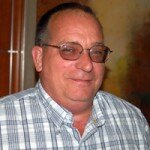
Rahul Karamchandani, MD, a neurologist at the UC Comprehensive Stroke Center. Photo by Cindy Starr.
In the world of stroke care, stories abound about patients who received the clot-busting drug tPA during the 4.5-hour treatment window and were discharged from the hospital with all or most of their abilities intact. Yet these patients remain a small minority of the millions of people who experience a stroke each year. What happens to those who do not get to the hospital in time, who do not qualify for tPA, or who suffer disability despite treatment is a prime interest of Rahul Karamchandani, MD.
Dr. Rahul Karamchandani (pronounced RA-hull Kah-RUM-chun-DAHN-ee), who joined the UC Comprehensive Stroke Center in 2014, has taken the helm of the Stroke Team Assessment and Recovery Treatment (START) Program at the Daniel Drake Center for Post-Acute Care.
Dr. Karamchandani, an assistant professor of neurology and rehabilitation medicine, hopes to expand the multidisciplinary START clinic, which is currently held one day each month and is part of the emerging and enormously hopeful field of long-term recovery, rehabilitation and renewal.
“The clinic targets patients who have already received standard therapies after a stroke,” Dr. Karamchandani says. “Typically, that involves a course of physical therapy, occupational therapy, and speech therapy. After this course of standard care, what usually follows is a gray zone where patients don’t know what to do or where to go or whom to follow up with. They usually follow up with their primary care doctor, which is OK, but our START recovery clinic offers an opportunity to go beyond the standard treatment.”
Patients who are referred to the clinic are evaluated by an interdisciplinary team of therapists and by a neurologist who specializes in stroke care. They may also see a specialist in physical medicine & rehabilitation.
“Through START, our patients are seen through fresh sets of eyes,” Dr. Karamchandani says. “There is a multidisciplinary approach and the potential to enroll in a clinical trial that might further their recovery.”
Clinical trials in stroke recovery
At present, the START program lists two clinical trials in stroke recovery on UC Health’s Clinical Trials page.
• High-Intensity Interval Training In Chronic Stroke
• The Niche Trial: Stroke Recovery Therapy Using Brain Stimulation
“Stroke recovery research is a huge, hot topic in research,” Dr. Karamchandani says. “It happens to be a research interest of mine, and we’re always trying to recruit patients into our studies. We want to develop better treatments for our current patients and for everyone who comes after them. We screen our patients to participate in trials studying different rehabilitation methods.”
Dr. Karamchandani hopes to be able to offer a novel study this year for people who have a condition called “neglect,” a situation that occurs when stroke survivors no longer pay attention to one side of their “world.”
Non-physical problems are common after stroke
Dr. Karamchandani was touched by the plight of stroke survivors during his residency at the University of Michigan.
“We commonly think of people who have a stroke as having weakness on one side of the body or numbness, or trouble with their speech or vision,” he says. “Those are all physical issues. But many patients have non-physical problems. They have fatigue after a stroke; they have a cognitive problem; their memory skills are not what they used to be. They have mood issues; they’re anxious, depressed; they have emotional ups and downs. They can’t function at work even though they’re physically OK. I’ve had so many people coming into the clinic saying they have these non-physical issues, and I think it made me want to look more into this recovery side and figure out what could we do not just for the physical symptoms, but for the non-physical as well.”
Dr. Karamchandani notes that the population of stroke survivors with disability is large in part because only a small percentage of patients are treated with tPA. “We of course want to increase those numbers, but the numbers are nevertheless small,” he says.
“We also have new therapies for acute stroke that were shown to help patients in recent clinical trials. These therapies involve endovascular (in-the-artery) devices that go into the brain and pull out blood clots. But once again, only a small minority of patients are eligible for these therapies.
“So that leaves a large majority who are in a recovery basket that is under-emphasized. I’m hoping to make things better for these patients.”
Candidates for the START program include those who suffered a stroke
at least six months ago and are seeking a fuller recovery.
For more information, please contact Lucretia White, MBA, BSN, RN,
at (513) 418-2549 or [email protected].
— Cindy Starr






